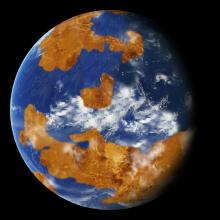Listen to today's episode of StarDate on the web the same day it airs in high-quality streaming audio without any extra ads or announcements. Choose a $8 one-month pass, or listen every day for a year for just $30.
You are here
Moon and Venus
Venus is a world you wouldn’t want to visit. Surface temperatures are hot enough to melt lead. The atmospheric pressure is equal to being almost two-thirds of a mile deep in Earth’s oceans. And the atmosphere is made almost entirely of carbon dioxide. Paradise it’s not.
Research over the last few decades, though, suggests that Venus could have been much more pleasant when it was young — perhaps pleasant enough for life. A study reported this fall, for example, suggests that temperatures could have remained comfortable for two billion years or longer.
The study built on observations by orbiting spacecraft. The probes found that Venus once had a lot of water on its surface. The study simulated conditions with different amounts of water — from damp soil to a global ocean. It also considered the amount of energy Venus received from the Sun, and other factors.
The conclusion was that Venus could have maintained surface temperatures of about 70 to 110 degrees Fahrenheit. That’s much warmer than modern-day Earth, but fairly comfortable for life. And that environment could have been maintained until less than a billion years ago, when molten rock began to repave the surface. So if life ever appeared on Venus, it could have had a comfortable home for a long time.
Venus is climbing higher into the evening sky. It’s the brilliant “evening star.” It’s just above the crescent Moon tonight, and a bit farther to the lower right of the Moon tomorrow night.
Script by Damond Benningfield






